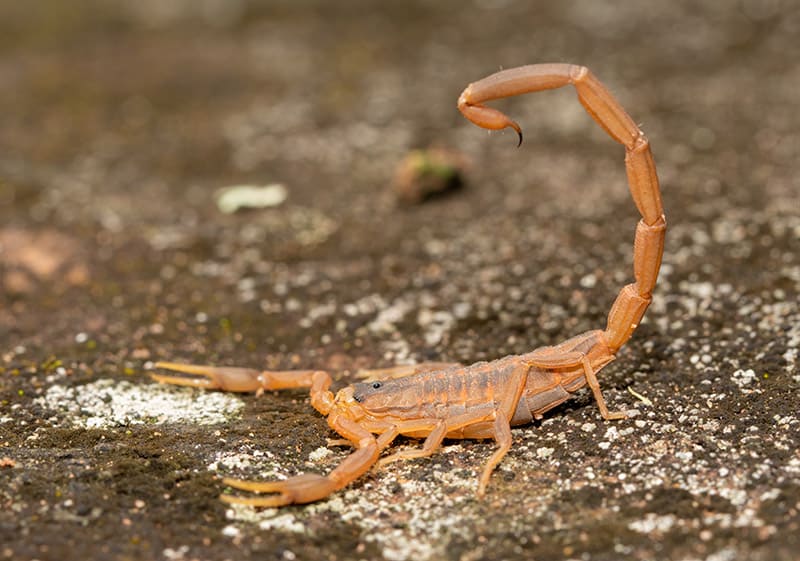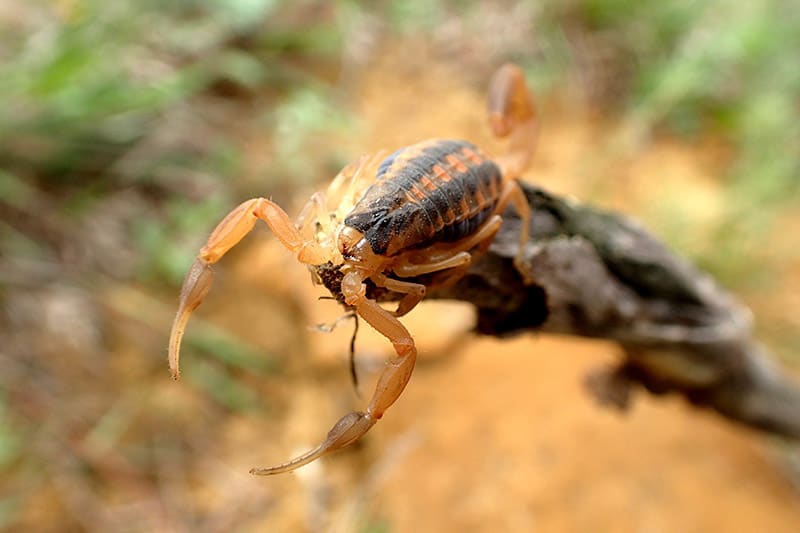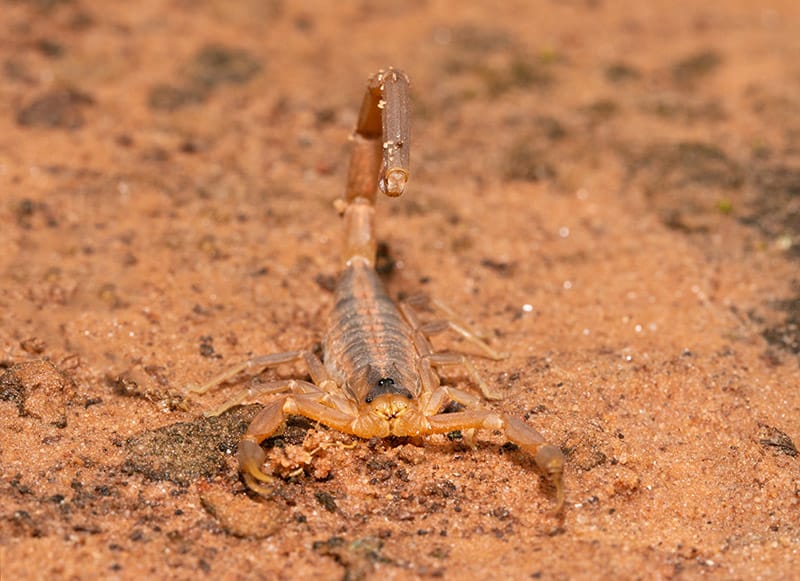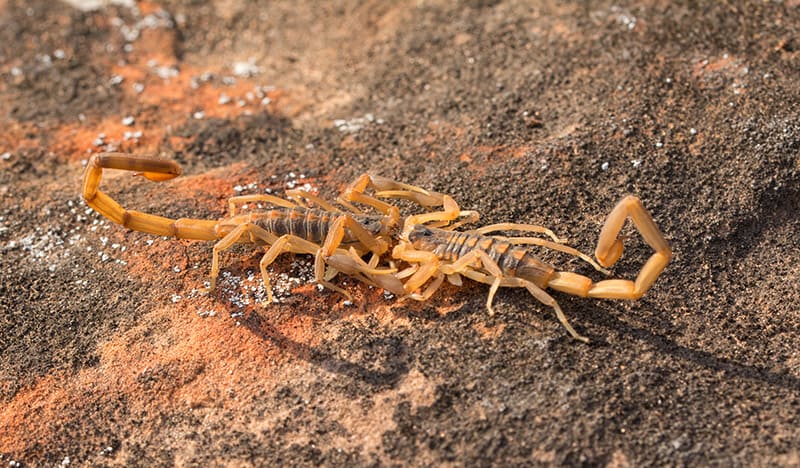The Striped Scorpion is very small scorpion, but its sting carries a big punch!
The Striped Scorpion or Striped Bark Scorpion Centruroides vittatus, is the most widespread scorpion in the United States. This is an extremely small scorpion, an adult only reaches about an inch in total length, though they can get up about 1 1/2. They are variable in color and pattern, generally a light orange or reddish color with darker two dark, longitudinal stripes on its carapace and a dark triangular mark on its head.
The Striped Scorpion does not make a handleable pet. This small species has a powerful sting that often produces intense pain that can last for several hours for most, but can last 2-3 days in some individuals. Other than this pain and a red welt that shortly disappears, there are rarely any other medical complications. A few people have an allergic reaction to the venom, and more severe symptoms, and children can be more at risk.
Though it won’t take up much space, the Striped Scorpion can be a great curiosity and is fun to observe. An interesting feature related to the native habitat of the Striped Scorpion is its ability to remain alive during extended periods of below freezing weather. Recent studies show that species capable of living through these conditions have a protein-like substance that allows them to survive by “trapping” ice crystals in their gut.
- For more information on keeping scorpions, see: Keeping Arachnids and Other Arthropods as Pets
Scientific Classification
| Kingdom: | Animalia |
| Phylum: | Arthropoda |
| Class: | Arachnida |
| Order: | Scorpiones |
| Family: | Buthidae |
| Genus: | Centruroides |
| Species: | vittatus |
Scientific Name

Habitat: Distribution/Background
The Striped Scorpion Centruroides vittatus was described by Say in 1863. These scorpions are found across a wide range in the United States from Texas, Oklahoma, Kansas, and beyond, and in northern Mexico. They are often found living communally in large numbers under flat stones, near ponds, and in rock-strewn cattle pastures. Other common names they are known by are Striped Scorpion, Common Striped Scorpion, Texas bark scorpion, Southern Bark Scorpion, Plains Scorpion, and Wood Scorpion.
Status
The Centruroides vittatus are not on the IUCN Red List for Endangered Species.
Description
The Striped Scorpion is a smaller species. It reaches a total body length reaching from 1″ up to about 2 1/2 – 3″, with males somewhat longer and thinner. They are variable in color and pattern, generally a light orange or reddish color with darker two dark, longitudinal stripes on its carapace and a dark triangular mark on its head. Specimens from Oklahoma and Kansas are darker with light orange. Specimens from West Texas tend to be more pale with lighter yellow.
Note: The Striped Scorpion has a strong sting (equal to a wasp sting for most people) for its small size. Many Centruroides species are quite dangerous, including the Arizona Bark Scorpion Centruroides exilicauda, and many of the species from Central and South America.

Food and Feeding
The Striped Scorpion feeds on worms, spiders, crickets, and other small invertebrates in nature. In captivity they feed well on crickets, waxworms, and even small mealworms. They will occasionally feed on smaller specimens of their own species and are preyed upon by centipedes, grasshoppers, mice, and several species of snakes.
Housing
Up to a dozen specimens can be kept in a ten-gallon terrarium with a substrate of 2 – 3″ (5 – 8 cm) of sand and peat moss (3/4 sand and 1/4 peat moss mixture). This size of an enclosure gives you room to provide interesting hiding places, preferably provide several hides. Decorations can include pieces of cholla wood, sturdy rock piles, and pieces of bark. Water in a flat dish should always be available.
A sturdy screen top will keep other household pets and small children out of the enclosure.
Temperature and humidity requirements:
Heat should be provided for this species, either by a heat pad underneath the enclosure or by a small heat lamp overhead. The goal is a daytime temperature of 75° to 82° F and a nighttime drop to 72° to 76° F.
A word of caution, glass terrariums can heat up very quickly. Even though these scorpions are from the deserts of southwestern United States, the extreme heat will kill these scorpions quite quickly. You can should set up the heat lamp on the sturdy screen top a few days before adding the scorpions to the enclosure to make sure the conditions are correct. These scorpions should be misted lightly once a week with a spray bottle
Cage Care
A good habit to get into is cleaning up any uneaten prey items the day after feeding your scorpion as decaying organic matter commonly attracts mites, fungus, mold and other potentially harmful organisms into the enclosure. If your pet has recently molted, remove uneaten prey items immediately. Newly molted scorpions are vulnerable until their exoskeletons hardens.

Behavior
The Striped Scorpion is communal and up to a dozen specimens can be kept in a ten-gallon terrarium.
Handling
This small scorpion packs a wallop. Its sting has been likened to a wasp sting by most victims. Most Centruroides are potent and some species are considered medically dangerous. The Striped Scorpion should be afforded careful respect. Manipulate all of the Centruroides species using paint brushes, tubs, and other tools rather than “tailing them”.
Reproduction
Males are somewhat slender with elongated metasomal segments of the tail. Females are shorter and often bulkier than males. This species will readily breed in captivity.
Courtship of the Striped Scorpion has been studied fairly extensively by invertebrate biologists and is fairly typical of a number of Centruroides species. Courtship is initiated by the female upon an encounter with a male. The male quickly grasps the pincers of the female and begins a shaking action known as “juddering”. Then, after a short shoving match, the male deposits a spermatophore onto the substrate and positions the female over the packet of sperm. The female lowers her abdomen and picks up the spermatophore into her genital opening. The two separate and often beat a hasty retreat in opposite directions.
After a gestation period of eight months the females produce from fifteen to forty babies.
Diseases: Ailments/Treatments
Scorpions are generally quite hardy and adaptable if they are provided with the right environment. A few signs that may indicate that your pet is not acting or feeling normal are a loss of appetite, acting listless or sluggish, having an overly swollen stomach, and missing or deformed limbs. Another problem can be an infestation of mites.
- Molting
One of the most common reasons for the death in scorpions is the molt. The scorpion has a tough outer covering, a cuticle, that forms a rigid exoskeleton. All scorpions must shed their old exoskeleton and secrete a new one in order to grow, this is called the molt. Scorpions will molt from 6 to 10 times during their lifetime. This molting process takes a lot of energy and they are very vulnerable for a couple of days after the molt until their new skin hardens
For about 24 hours prior to molting it is not unusual for a scorpion to get quite sluggish.
A difficult molt can result in lost or deformed limbs, or death. This is thought to be related to humidity levels. There can be either too much humidity or too little, depending on the species. In captivity a lot of immature scorpions die during the molting process. - Other Problems
Though many scorpions can go for long periods of time without eating, overfeeding can cause an overly swollen stomach as well as the loss of appetite, and even death. The stomach can be slightly swollen from regular eating, and this is not a problem.
Another problem can be an infestation of Mites. Uneaten food can attract mites, which are very dangerous and stressful to scorpions. Be sure to remove old food.

Availability
The Striped Scorpion is commonly available (and quite inexpensive) from dealers who offer scorpions.
This species is very common in many areas of the United States. It lives communally and so is often collected in moderate to large numbers. Unfortunately, it is only available as wild-caught specimens as it is only being bred by a small number of keepers so far.
Featured Image Credit: Jay Ondreicka, Shutterstock
